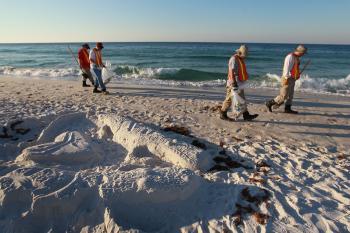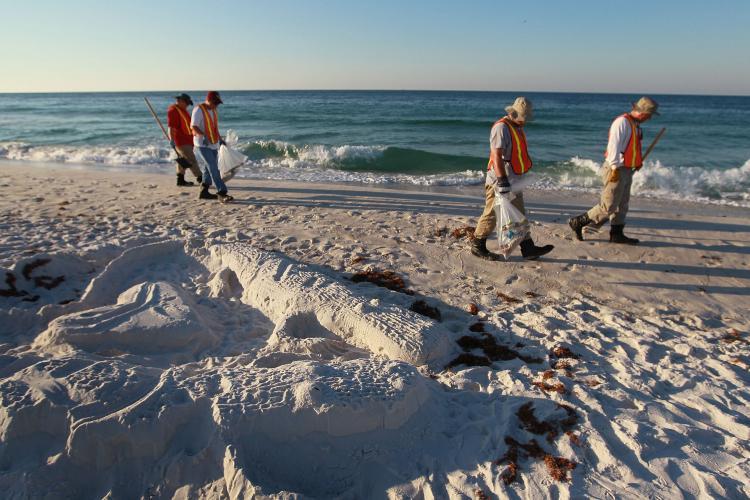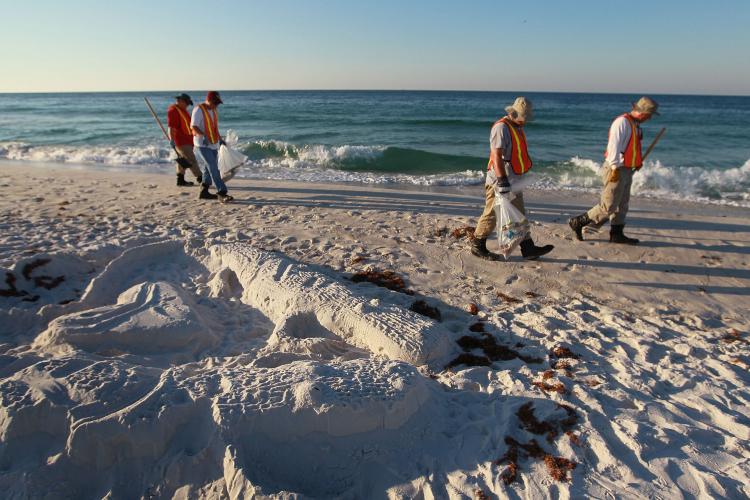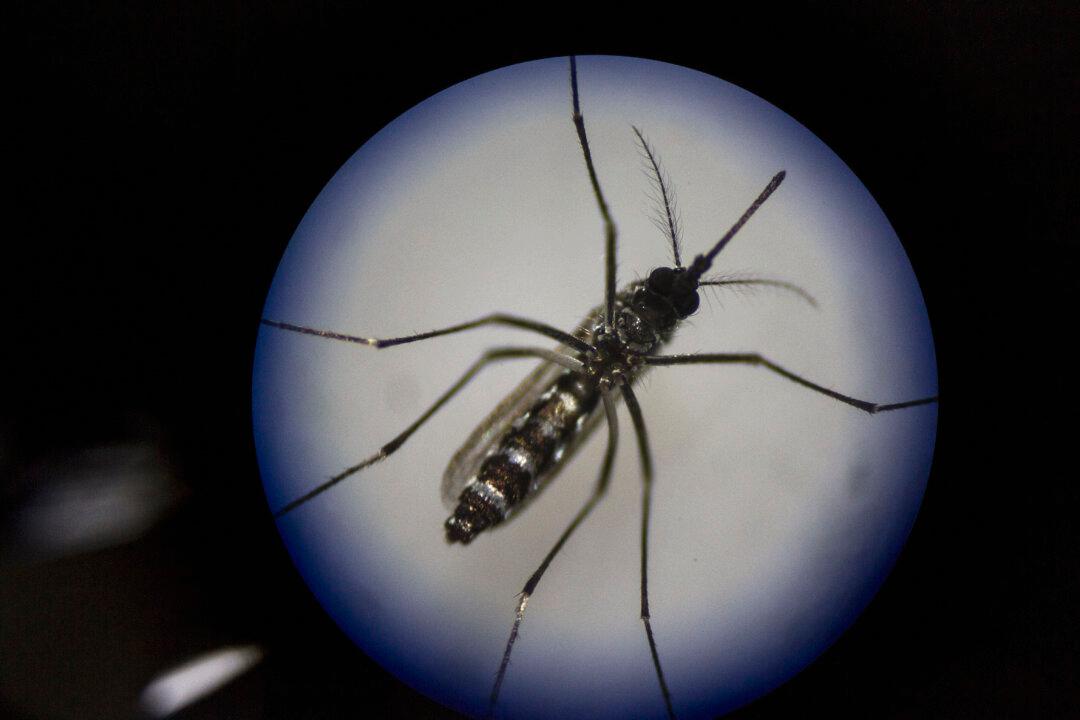Even as British Petroleum and the U.S. government have clashed in public over the toxicity of the oil dispersant BP has used on the Gulf oil spill and workers cleaning up the spill have been hospitalized apparently due to the toxic effects of the oil and dispersant mixture, a large quantity of a less toxic dispersant has been sitting in a warehouse in Norway waiting to be shipped to the gulf.
According to Mr. Sjur W. Knudsen, the managing director of the Norwegian Clean Seas Association for Operating Companies (NOFO, the organization tasked with responding to oil spills in Norway’s waters), the order placed on May 3 by BP Exploration and Production out of Tulsa, Oklahoma for approximately 150 metric tons of the dispersant Dasic Slickgone has been held up due to “bureaucratic red tape” in the United States.
Dasic Slickgone does not appear on the EPA’s list of twelve “pre-approved” oil dispersants in the National Contingency Plan Product Schedule and to be used in the United States would require special approval from the EPA.
The day before BP placed the order with NOFO, on May 2, CNBC reported that BP had bought the “entire inventory” of the oil dispersant product Corexit 9500™, which represents 95 percent of the U.S. market for oil dispersants.
The milder, soap-water-like Dasic Slickgone, made by Dasic International Ltd., in the United Kingdom, is the main oil dispersant approved for use in the North Sea, due to its lower toxicity. It has been tested, studied, and used during NOFO’s unique annual drill: “We conduct an outdoor laboratory, in which we pump oil into the sea to simulate a real oil spill,” Mr. Knudsen explained.
Norway is also one of the few places in the world to warehouse such a large quantity of oil dispersants available to be shipped at a moment’s notice.
The dispersant Corexit 9500 that BP has been spraying over the Gulf spill and injecting one mile deep into the blowout vent, is banned by the UK and Norway, due to its high toxicity. “[Corexit] 9500 is forbidden to use in the North Sea offshore oil industry,” Mr. Knudsen explained.
Mr. John Belk, Technical Director at Dasic International, Ltd, claimed in an email that “Dasic is the dispersant of choice in many of the other areas around the world, including South Africa, Saudi Arabia & Kuwait, Singapore, New Zealand & Australia.”
Massive Amounts
BP has been using massive amounts of the oil dispersant Corexit 9500 to try to break up the Gulf Oil spill. As of May 24, Lisa Jackson, administrator of the EPA, estimated that BP had already used 700,000 gallons of the dispersant in the gulf.
On May 20, concerned about the toxicity of Corexit 9500, Ms. Jackson ordered BP to find an alternative to it within 24 hours, “if operationally possible.”
BP determined it had no other effective alternatives available in large quantities and failed to comply.
On May 27, Ms. Jackson testified before Congress that BP had reduced its use of dispersants from an estimated 70,000 gallons a day to 12,000 gallons a day.
At the same hearing, Ms. Jackson complained that BP was more interested in defending its choice to use Corexit than in finding other options.
‘An Uncontrolled Experiment’
Congressman Peter Defazio (D-Oregon) in a May 28 letter to Ms. Jackson urged her to prohibit the use of Corexit and said, “Based on EPA’s own National Contingency Plan Product Schedule, Corexit is one of the least effective and most toxic dispersants available on the market.”
At the May 27 Congressional hearing, Congressman Jerrod Nadler (D-New York) compared the use of Corexit to that of Agent Orange. He also said, “We are conducting an uncontrolled experiment with all the marine and human life in the Gulf Coast region that could result in thousands and thousands of people getting sick or dying.”
The Washington Post reported on May 27 that seven oil spill clean up workers were hospitalized with “nausea, dizziness, and headaches.”
The Louisiana TV station WDSU reported on one worker who does not smoke who was told by his doctor that his lungs resembled those of a three-pack-a-day smoker.
WDSU quoted marine toxicologist Riki Ott as saying the situation in the gulf is similar to the Exxon Valdez disaster, in which thousands of clean-up workers were sickened.
Some fisherman are continuing to work even though they are already sick, for fear of being fired by BP and being left without a job, according to WDSU.
Nalco, the manufacturer of Corexit 9500, says on its website that “All of the ingredients contained in Nalco’s dispersants are safe and found in common household products, such as food, packaging, cosmetics, and household cleaners. Individually and collectively the ingredients are safe when used as directed.”
‘Every Single Available Resource’
Mr. Belk confirmed the purchase order by BP of the Dasic Slickgone in Norway.
Officials at BP Deepwater Horizon refused to comment on why the Dasic Slickgone had not been shipped to the gulf. Information officer Ray Viator wrote in an email on June 3: “I checked with someone on the BP environmental team working with dispersants and she said she was not familiar with this product (Dasic).”
BP officials in Tulsa also refused to comment on why the Dasic Slickgone had not been shipped to the gulf.
The EPA chose not to respond to questions about why the shipment of Dasic Slickgone had not been approved for use in the Gulf.
On April 29 President Obama said, “We will use every single available resource to deal with the oil spill.” Until the EPA finds a way quickly to provide approval for an available, less toxic alternative to a more toxic product, President Obama’s words will be without effect.
James Ottar Grundvig as a young man worked in Norway’s offshore oil industry. Today he is a writer living in New York City.
According to Mr. Sjur W. Knudsen, the managing director of the Norwegian Clean Seas Association for Operating Companies (NOFO, the organization tasked with responding to oil spills in Norway’s waters), the order placed on May 3 by BP Exploration and Production out of Tulsa, Oklahoma for approximately 150 metric tons of the dispersant Dasic Slickgone has been held up due to “bureaucratic red tape” in the United States.
Dasic Slickgone does not appear on the EPA’s list of twelve “pre-approved” oil dispersants in the National Contingency Plan Product Schedule and to be used in the United States would require special approval from the EPA.
The day before BP placed the order with NOFO, on May 2, CNBC reported that BP had bought the “entire inventory” of the oil dispersant product Corexit 9500™, which represents 95 percent of the U.S. market for oil dispersants.
The milder, soap-water-like Dasic Slickgone, made by Dasic International Ltd., in the United Kingdom, is the main oil dispersant approved for use in the North Sea, due to its lower toxicity. It has been tested, studied, and used during NOFO’s unique annual drill: “We conduct an outdoor laboratory, in which we pump oil into the sea to simulate a real oil spill,” Mr. Knudsen explained.
Norway is also one of the few places in the world to warehouse such a large quantity of oil dispersants available to be shipped at a moment’s notice.
The dispersant Corexit 9500 that BP has been spraying over the Gulf spill and injecting one mile deep into the blowout vent, is banned by the UK and Norway, due to its high toxicity. “[Corexit] 9500 is forbidden to use in the North Sea offshore oil industry,” Mr. Knudsen explained.
Mr. John Belk, Technical Director at Dasic International, Ltd, claimed in an email that “Dasic is the dispersant of choice in many of the other areas around the world, including South Africa, Saudi Arabia & Kuwait, Singapore, New Zealand & Australia.”
Massive Amounts
BP has been using massive amounts of the oil dispersant Corexit 9500 to try to break up the Gulf Oil spill. As of May 24, Lisa Jackson, administrator of the EPA, estimated that BP had already used 700,000 gallons of the dispersant in the gulf.
On May 20, concerned about the toxicity of Corexit 9500, Ms. Jackson ordered BP to find an alternative to it within 24 hours, “if operationally possible.”
BP determined it had no other effective alternatives available in large quantities and failed to comply.
On May 27, Ms. Jackson testified before Congress that BP had reduced its use of dispersants from an estimated 70,000 gallons a day to 12,000 gallons a day.
At the same hearing, Ms. Jackson complained that BP was more interested in defending its choice to use Corexit than in finding other options.
‘An Uncontrolled Experiment’
Congressman Peter Defazio (D-Oregon) in a May 28 letter to Ms. Jackson urged her to prohibit the use of Corexit and said, “Based on EPA’s own National Contingency Plan Product Schedule, Corexit is one of the least effective and most toxic dispersants available on the market.”
At the May 27 Congressional hearing, Congressman Jerrod Nadler (D-New York) compared the use of Corexit to that of Agent Orange. He also said, “We are conducting an uncontrolled experiment with all the marine and human life in the Gulf Coast region that could result in thousands and thousands of people getting sick or dying.”
The Washington Post reported on May 27 that seven oil spill clean up workers were hospitalized with “nausea, dizziness, and headaches.”
The Louisiana TV station WDSU reported on one worker who does not smoke who was told by his doctor that his lungs resembled those of a three-pack-a-day smoker.
WDSU quoted marine toxicologist Riki Ott as saying the situation in the gulf is similar to the Exxon Valdez disaster, in which thousands of clean-up workers were sickened.
Some fisherman are continuing to work even though they are already sick, for fear of being fired by BP and being left without a job, according to WDSU.
Nalco, the manufacturer of Corexit 9500, says on its website that “All of the ingredients contained in Nalco’s dispersants are safe and found in common household products, such as food, packaging, cosmetics, and household cleaners. Individually and collectively the ingredients are safe when used as directed.”
‘Every Single Available Resource’
Mr. Belk confirmed the purchase order by BP of the Dasic Slickgone in Norway.
Officials at BP Deepwater Horizon refused to comment on why the Dasic Slickgone had not been shipped to the gulf. Information officer Ray Viator wrote in an email on June 3: “I checked with someone on the BP environmental team working with dispersants and she said she was not familiar with this product (Dasic).”
BP officials in Tulsa also refused to comment on why the Dasic Slickgone had not been shipped to the gulf.
The EPA chose not to respond to questions about why the shipment of Dasic Slickgone had not been approved for use in the Gulf.
On April 29 President Obama said, “We will use every single available resource to deal with the oil spill.” Until the EPA finds a way quickly to provide approval for an available, less toxic alternative to a more toxic product, President Obama’s words will be without effect.
James Ottar Grundvig as a young man worked in Norway’s offshore oil industry. Today he is a writer living in New York City.







